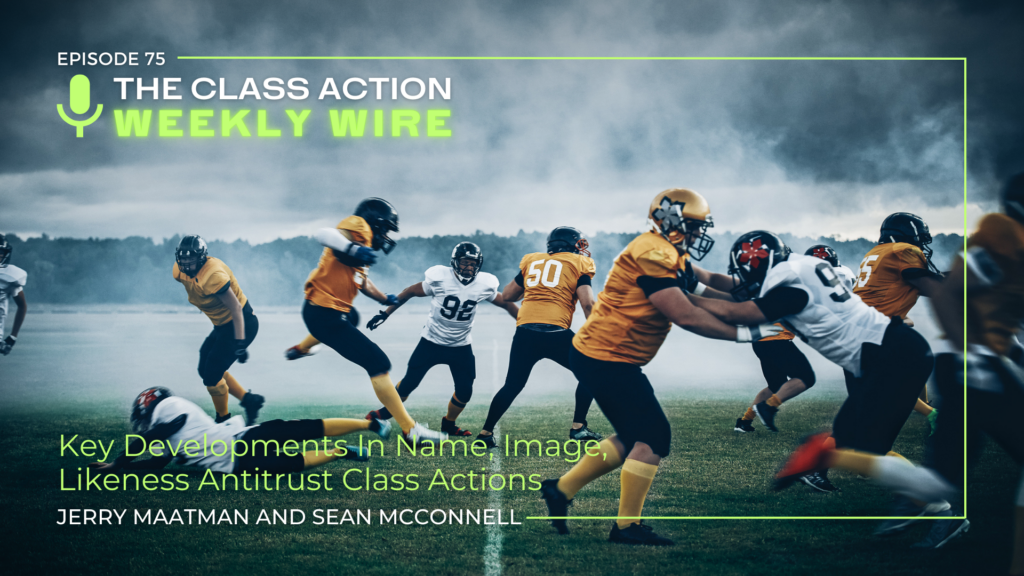
Duane Morris Takeaway: This week’s episode of the Class Action Weekly Wire features Duane Morris partners Jerry Maatman and Sean McConnell with their analysis of class action litigation in the antitrust space involving student-athletes and their Name, Image, Likeness (“NIL”) claims.
Check out today’s episode and subscribe to our show from your preferred podcast platform: Spotify, Amazon Music, Apple Podcasts, Samsung Podcasts, Podcast Index, Tune In, Listen Notes, iHeartRadio, Deezer, and YouTube.
Episode Transcript
Jerry Maatman: Thank you, loyal blog readers and listeners, for joining us for this episode of the Class Action Weekly Wire. It’s my privilege and honor to introduce Sean McConnell, who chairs Duane Morris’ antitrust group, who’s joining us today to talk about all things antitrust in the class action space. Welcome, Sean.
Sean McConnell: Great to be here. Thanks for having me, Jerry.
Jerry: Today we wanted to discuss a newsworthy lawsuit, the filing of which has been reported wide and far. A federal court lawsuit filed against the NCAA and various universities called Robinson v. NCAA. What should our listeners and readers know about that case? What does it mean?
Sean: Thanks, Jerry. Well, we’ve talked several times about the name, image, and likeness, or NIL, antitrust class actions that have been filed against the National Collegiate Athletic Association, or NC2A, and various athletic conferences. Arguing that past prohibitions by the NCAA preventing athletes from being compensated for their name, image, and likeness and various issues have arisen related to those claims leading to litigation. And this Robinson case is one of the latest in those lines of cases. This case was filed by former University of Michigan football players, who were NCAA student-athletes prior to June 15, 2016 on similar grounds to the House NCAA case. But the House case, that class only went back to 2016. So this this new Robinson case is for student-athletes that played sports for NC2A colleges before 2016, on grounds of a continuing violation theory basically that the settlement proceeds should extend back beyond 2016 and cover their prohibition on compensation dating back before that time, arguing that they should have been compensated for their name, image, and likeness, as well as the plaintiffs in the House case.
Jerry: These types of NIL cases seem to be at the forefront of antitrust class action litigation involving universities. And it seemed like when the NCAA lifted the restrictions on compensation for student-athletes, it opened, so to speak, the floodgates of litigation. Is that what you’re seeing in terms of the poll side of the courthouse?
Sean: That’s exactly right, Jerry. Now that student-athletes are able to be compensated for their name, image, and likeness – which athletes were not able to do so, for you know, over a hundred years – we’re now seeing, you know, several antitrust class actions being filed against member institutions of the NCAA and the NCAA itself for money that they believe they should have been able to earn, whether it’s from television revenue sharing, from their name, image, and likeness being sold on jerseys and other memorabilia that was sold by the schools and by other third parties. So that is certainly the current trend.
Jerry: There’s certainly a lot of money at issue. If you become a little more granular and drill down into the theories of recovery in the Robinson lawsuit that has just been filed, what is it exactly that the plaintiffs are trying to recover?
Sean: Sure. So the theory of the case in Robinson is that the NCAA, its member institutions, and then, you know, networks such as the Big 10 Network that profited off of the name, image, and likeness of student-athletes by selling television rights and broadcasting games in which those players played – that much like players in professional leagues are compensated through revenue-sharing programs from television rights – that the plaintiffs in the Robinson case believe that they are entitled to a revenue share from the use of their name, image, and likeness, from television distribution, as well as from various products sold by those institutions.
Jerry: Well, thanks for that update and that analysis. I’m sure we’ll be circling back to you when the litigation proceeds to the class action certification stage – obviously, the Holy Grail in any class action that the plaintiffs are seeking. Also wanted to talk a little bit about the recent ruling a few weeks ago, where a federal district court judge declined to approve a class action settlement on antitrust theories against the NCAA to the tune of a $2.78 billion class-wide settlement. Tell our readers and listeners a little bit about how that came about?
Sean: Sure. So that’s the House antitrust case that I that I mentioned earlier, which covers student athletes from 2016 to the present. And as you as you referenced Jerry, I mean the settlement amount was quite large at first blush. I mean the notion that student-athletes would now be entitled to, you know, almost $3 billion in compensation from member institutions and conferences. But the problem with the settlement, as some objectors raised, and as the court took note of, was that apportioning different amounts of the revenue share by conference by school still amounted to seemingly price-fixing, because when you’re setting the limits on how much revenue can be shared with different student athletes, even as part of a settlement, those revenue sharing programs and limits on what certain conferences or certain schools could do from a revenue perspective, how different collectives organized by school could compensate student athletes, even as part of the settlement still amounted to, you know, apparently price-fixing, and that’s what the court was concerned with those limits, and whether that still constituted a Sherman Act violation. And so the judge told the parties to go back to the drawing board and try to work out a fix that was a little bit you know more in line with the antitrust laws.
Jerry: That’s so interesting, and certainly a blockbuster settlement in 2024. And one would think that the parties are going to reboot, do a 2.0 settlement, so to speak, and put that before the court – apt to be one of the largest settlements that we report on this coming January, when we publish the Duane Morris Class Action Review, as well as the mini-book on antitrust class action litigation that you’re an author of. Well, thank you so much for Sean, for joining us and lending your thought leadership and expertise. It’s been great to speak with you.
Sean: Thank you, Jerry. It’s been great to be here again.

